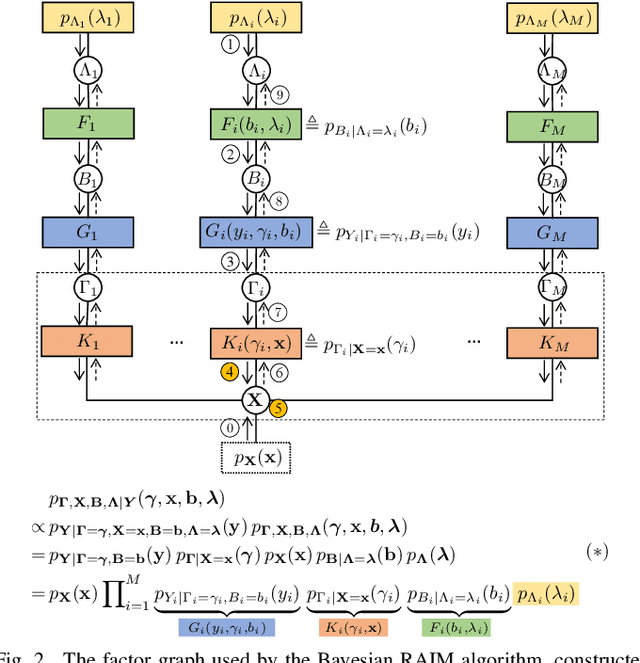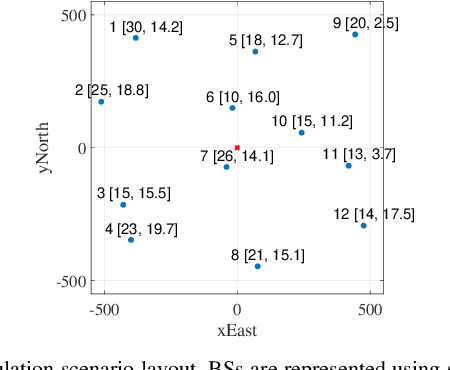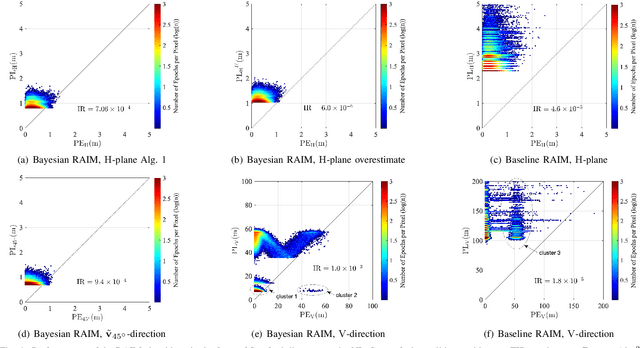Liqin Ding
Improving 3D Cellular Positioning Integrity with Bayesian RAIM
Aug 09, 2024



Abstract:Ensuring positioning integrity amid faulty measurements is crucial for safety-critical applications, making receiver autonomous integrity monitoring (RAIM) indispensable. This paper introduces a Bayesian RAIM algorithm with a streamlined architecture for snapshot-type 3D cellular positioning. Unlike traditional frequentist-type RAIM algorithms, it computes the exact posterior probability density function (PDF) of the position vector as a Gaussian mixture (GM) model using efficient message passing along a factor graph. This Bayesian approach retains all crucial information from the measurements, eliminates the need to discard faulty measurements, and results in tighter protection levels (PLs) in 3D space and 1D/2D subspaces that meet target integrity risk (TIR) requirements. Numerical simulations demonstrate that the Bayesian RAIM algorithm significantly outperforms a baseline algorithm, achieving over $50\%$ PL reduction at a comparable computational cost.
Low Peak-to-Average Power Ratio FBMC-OQAM System based on Data Mapping and DFT Precoding
Sep 11, 2023



Abstract:Filter bank multicarrier with offset quadrature amplitude modulation (FBMC-OQAM) is an alternative to OFDM for enhanced spectrum flexible usage. To reduce the peak-to-average power ratio (PAPR), DFT spreading is usually adopted in OFDM systems. However, in FBMC-OQAM systems, because the OQAM pre-processing splits the spread data into the real and imaginary parts, the DFT spreading can result in only marginal PAPR reduction. This letter proposes a novel map-DFT-spread FBMC-OQAM scheme. In this scheme, the transmitting data symbols are first mapped with a conjugate symmetry rule and then coded by the DFT. According to this method, the OQAM pre-processing can be avoided. Compared with the simple DFT-spread scheme, the proposed scheme achieves a better PAPR reduction. In addition, the effect of the prototype filter on the PAPR is studied via numerical simulation and a trade-off exists between the PAPR and out-of-band performances.
Bayesian Integrity Monitoring for Cellular Positioning -- A Simplified Case Study
Nov 14, 2022Abstract:Bayesian receiver autonomous integrity monitoring (RAIM) algorithms are developed for the snapshot cellular positioning problem in a simplified one-dimensional (1D) linear Gaussian setting. Position estimation, multi-fault detection and exclusion, and protection level (PL) computation are enabled by the efficient and exact computation of the position posterior probabilities via message passing along a factor graph. Computer simulations demonstrate the significant performance improvement of the proposed Bayesian RAIM algorithms over a baseline advanced RAIM algorithm, as it obtains tighter PLs that meet the target integrity risk (TIR) requirements.
 Add to Chrome
Add to Chrome Add to Firefox
Add to Firefox Add to Edge
Add to Edge